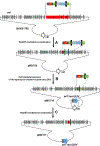Engineering Salinispora tropica for heterologous expression of natural product biosynthetic gene clusters
- PMID: 30105571
- PMCID: PMC6139059
- DOI: 10.1007/s00253-018-9283-z
Engineering Salinispora tropica for heterologous expression of natural product biosynthetic gene clusters
Abstract
The marine actinomycete genus Salinispora is a remarkably prolific source of structurally diverse and biologically active secondary metabolites. Herein, we select the model organism Salinispora tropica CNB-440 for development as a heterologous host for the expression of biosynthetic gene clusters (BGCs) to complement well-established Streptomyces host strains. In order to create an integratable host with a clean background of secondary metabolism, we replaced three genes (salA-C) essential for salinosporamide biosynthesis with a cassette containing the Streptomyces coelicolor ΦC31 phage attachment site attB to generate the mutant S. tropica CNB-4401 via double-crossover recombination. This mutagenesis not only knocks-in the attachment site attB in the genome of S. tropica CNB-440 but also abolishes production of the salinosporamides, thereby simplifying the strain's chemical background. We validated this new heterologous host with the successful integration and expression of the thiolactomycin BGC that we recently identified in several S. pacifica strains. When compared to the extensively engineered superhost S. coelicolor M1152, the production of thiolactomycins from S. tropica CNB-4401 was approximately 3-fold higher. To the best of our knowledge, this is the first example of using a marine actinomycete as a heterologous host for natural product BGC expression. The established heterologous host may provide a useful platform to accelerate the discovery of novel natural products and engineer biosynthetic pathways.
Keywords: Genetic engineering; Heterologous expression; Natural products; Salinispora.
Conflict of interest statement
Figures



Similar articles
-
Heterologous expression of natural product biosynthetic gene clusters in Streptomyces coelicolor: from genome mining to manipulation of biosynthetic pathways.J Ind Microbiol Biotechnol. 2014 Feb;41(2):425-31. doi: 10.1007/s10295-013-1348-5. Epub 2013 Oct 6. J Ind Microbiol Biotechnol. 2014. PMID: 24096958 Review.
-
Discovery, characterization, and engineering of an advantageous Streptomyces host for heterologous expression of natural product biosynthetic gene clusters.Microb Cell Fact. 2024 May 24;23(1):149. doi: 10.1186/s12934-024-02416-y. Microb Cell Fact. 2024. PMID: 38790014 Free PMC article.
-
Metabolic engineering of Streptomyces coelicolor for enhanced prodigiosins (RED) production.Sci China Life Sci. 2017 Sep;60(9):948-957. doi: 10.1007/s11427-017-9117-x. Epub 2017 Aug 1. Sci China Life Sci. 2017. PMID: 28785950
-
Engineering of Streptomyces lividans for heterologous expression of secondary metabolite gene clusters.Microb Cell Fact. 2020 Jan 9;19(1):5. doi: 10.1186/s12934-020-1277-8. Microb Cell Fact. 2020. PMID: 31918711 Free PMC article.
-
Genetic manipulation of secondary metabolite biosynthesis for improved production in Streptomyces and other actinomycetes.J Ind Microbiol Biotechnol. 2016 Mar;43(2-3):343-70. doi: 10.1007/s10295-015-1682-x. Epub 2015 Sep 12. J Ind Microbiol Biotechnol. 2016. PMID: 26364200 Review.
Cited by
-
Recent Advances in the Heterologous Expression of Biosynthetic Gene Clusters for Marine Natural Products.Mar Drugs. 2022 May 24;20(6):341. doi: 10.3390/md20060341. Mar Drugs. 2022. PMID: 35736144 Free PMC article. Review.
-
Bacteria as genetically programmable producers of bioactive natural products.Nat Rev Chem. 2020 Apr;4(4):172-193. doi: 10.1038/s41570-020-0176-1. Epub 2020 Mar 23. Nat Rev Chem. 2020. PMID: 37128046 Review.
-
Genetic platforms for heterologous expression of microbial natural products.Nat Prod Rep. 2019 Sep 1;36(9):1313-1332. doi: 10.1039/c9np00025a. Epub 2019 Jun 14. Nat Prod Rep. 2019. PMID: 31197291 Free PMC article. Review.
-
Genomic Insights and Synthetic Biology Applications of Marine Actinomycete Streptomyces griseoincarnatus HNS054.Int J Mol Sci. 2024 Mar 8;25(6):3127. doi: 10.3390/ijms25063127. Int J Mol Sci. 2024. PMID: 38542100 Free PMC article.
-
Direct cloning and heterologous expression of natural product biosynthetic gene clusters by transformation-associated recombination.Methods Enzymol. 2019;621:87-110. doi: 10.1016/bs.mie.2019.02.026. Epub 2019 Mar 21. Methods Enzymol. 2019. PMID: 31128791 Free PMC article.
References
-
- Baltz RH (2010) Streptomyces and Saccharopolyspora hosts for heterologous expression of secondary metabolite gene clusters. J Ind Microbiol Biotechnol 37(8):759–72 - PubMed
-
- Baltz RH (2016) Genetic manipulation of secondary metabolite biosynthesis for improved production in Streptomyces and other actinomycetes. J Ind Microbiol Biotechnol 43(2–3):343–70 - PubMed
-
- Berdy J (2005) Bioactive microbial metabolites. J Antibiot (Tokyo) 58(1):1–26 - PubMed
MeSH terms
Substances
Grants and funding
LinkOut - more resources
Full Text Sources
Other Literature Sources
Molecular Biology Databases

